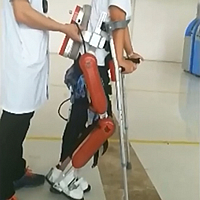
The AIDER system and its clinical applications
Wang, Yilin; Cheng, Hong; Qiu, Jing; Zhang, Anren; He, Hongchen
Sci China Inf Sci, 2021, 64(8): 184201
Spinal cord injury (SCI) significantly affects thousands of individuals every year. SCI is due to various pathogenic factors such as trauma, inflammation, and tumors. SCI caused spinal neurological dysfunction below the injury plane, e.g., it affects motor, sensory nerve, sphincter, and vegetative nerve function. A robotic exoskeleton system is an emerging rehabilitation therapy for SCI worldwide. For patients with SCI, correction of gait and improvement of the function of the lower limbs during walking are particularly important. Hybrid assistive limb (HAL) was developed by Sankai and his team. It is mainly controlled by surface-electromyography (sEMG) signals which are gained by the sensors attached to the surface of muscles. HAL provided assistance to pilots to facilitate easier walking. Lokomat is the first-ever gait-training robot constructed for patients with SCI worldwide and is mainly composed of fixed hips, lower-limbs orthotic exoskeleton, body-weight support system, and treadmill. Some researchers [3–6] have performed clinical experiments to verify the effect of the use of Lokomat on gait rehabilitation. Patients with chronic complete/incomplete SCI have undergone gait rehabilitation training with Lokomat robots, and the results have shown a significant improvement in walking speed, walking distance, Timed Up and Go test results, and Walking Index for Spinal Cord Injury II (WISCI II) score. This study verified the safety and effectiveness of the assistive device for paralyzed patient (AIDER) system, which can improve the walking ability and spinal cord independence of patients with SCI. All aspects of this study were certified by the Ethics Committee of Sichuan University West China Hospital.